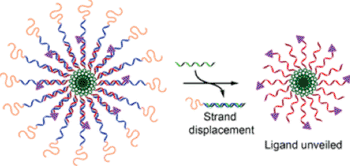Nanomolecular Agents Deployed to Detect Diseases
By LabMedica International staff writers
Posted on 22 Jan 2014
Pharmaceutical sleuthing has come closer to reality with the development of “nano-spy” compounds programmed to jump into play when they receive a specific signal.Posted on 22 Jan 2014
Scientist from the University of Nottingham’s (UK) School of Pharmacy have designed and evaluated large molecular complexes that will reveal their real identity only when they have reached their intended target.

Image: Soft micellar nanoparticles can be prepared from DNA conjugates designed to assemble via base pairing such that strands containing a polymer corona and a cholesterol tail generate controlled supramolecular architecture (Photo courtesy of Nanoscale).
The compounds have been developed as part of a five-year program funded by the Engineering and Physical Sciences Research Council (EPSRC) called Bar-Coded Materials. The cloak each spherical complex wears is a sheath of biocompatible polymer that encapsulates and covers biologically active material inside, preventing any biologic interaction so long as the shield remains in place. The intelligent part is in the DNA-based zips that hold the coat in position until triggered to undo. Because any DNA code (also known as a molecular cipher) can be chosen, the release mechanism can be bar-coded so that it is triggered by a specific biomarker—for example, a message from a disease gene.
What is then exposed—an active pharmaceutical agent, a molecular tag to attach to diseased tissue, or a molecular beacon to signal activation—depends on what function is required. Prof. Cameron Alexander, who leads the project, said, “These types of switchable nanoparticles could be extremely versatile. As well as initial detection of a medical condition, they could be used to monitor the progress of diseases and courses of treatment, or adapted to deliver potent drugs at particular locations in a patient’s body. It might even become possible to use mobile phones rather than medical scanners to detect programmed responses from later generations of the devices.”
The researchers, in their preliminary trials, have validated that the idea works in the test tube—the switchable molecular constructs do respond as predicted when presented with the correct molecular signals. The group is now working hard to move the project forwards.
An early application might be in dipstick technology—testing for specific infections in a blood or sputum, for example. But because the polymer coating (polyethylene glycol) is biocompatible, the researchers are hopeful that in the long run “self-authenticating medicines,” based on the approach could be injected into patients, to hunt for diseased tissue, and report their success.
“The key to this breakthrough has been the five-year EPSRC Leadership Fellowship awarded to me back in 2009,” noted Prof. Alexander. “This has provided the stability of funding to recruit and retain an outstanding team, who have been integral to realizing the ideas put forward in the Fellowship. It has also given us the freedom to explore a whole range of new concepts, as well as the time needed to test our ideas to bring this and other breakthroughs within reach.”
The study’s findings were published January 2014 in the journal Nanoscale.
Related Links:
University of Nottingham
EPSRC









 assay.jpg)



